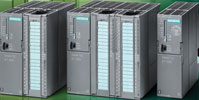

The Siemens Industry Automation Division has expanded its range of Simatic-S7-300 controllers and improved their performance. In the compact class, all six CPUs have been completely redesigned. They now have significantly enhanced performance and twice the RAM they used to have. The CPU 314C-2 PN/DP, a new addition, is the seventh CPU. This is the first compact CPU with a 2-port Profinet interface, and it is suitable for straightforward configuration of Profinet linear bus topologies. Among the standard controllers there is now the CPU 317-2 DP, and the fail-safe controllers have been supplemented by the CPU 317F-2 DP with new hardware and improved performance data. All the new CPUs are equipped with firmware version 3.3, allowing, for example, user programs to be executed up to nine times faster than with predecessor models. Some of the devices are also considerably slimmer than before. For example, the new standard and fail-safe CPU 317 with Profibus DP is only 40 millimetres wide instead of 80, and the new compact CPU 313C-2 PtP/DP measures 80 millimetres instead of 120.
Thanks to the firmware version 3.3 for the new CPUs, user programs are executed significantly faster than before. Bit commands, for example, now only require between 25 and 100 nanoseconds, compared to 50 to 200 nanoseconds previously. The performance of word, fixed-point and floating-point arithmetic commands has also been significantly increased. The user memory has doubled, starting now at 64 KB on the compact CPUs, and extending to 1536 KB on the
fail-safe CPU 317F-2 DP. The technical data have been adapted to the redesigned Simatic-S7-300-CPU devices. This makes it easier for users to port and re-use existing libraries and programs. Improved function block encryption has been additionally integrated into firmware version 3.3 to protect user know-how.
The CPU 314C-2 PN/DP is the first compact CPU with a 2-port Profinet interface. The two onboard interfaces with switch functionality can be used to implement Profinet linear bus topologies conveniently and cost-effectively, or to connect a PC, programming device or HMI (human machine interface) device. The user memory is 50% larger than the comparable CPU 314C, and the bit performance has been increased by a factor of 2,5. In addition, the new Profinet innovations from 2010 have been implemented: these include isochronous mode, intelligent CPU as IO-Device, Shared Device, Media Redundancy Protocol (MRP), assignment of the IP address from the user program, and user-defined websites. The integral webserver enables user-friendly system diagnostics with automatic page update and diagnostics buffer with up to 499 entries. The module status of connected Profinet nodes is indicated, for example, in table form. Users can identify faulty devices extremely easily via the graphical representation of the Profinet IO topology. For commissioning and service purposes, users can also integrate their own websites and protect website access via login and password. The integrated connection options for I/O devices correspond to those of the other 314er CPUs. These are 24 digital inputs and 16 digital outputs, as well as four analog inputs and two analog outputs.
For more information contact Keshin Govender, Siemens Southern Africa, +27 (0)11 652 2412, [email protected], www.siemens.co.za
| Tel: | +27 11 548 9960 |
| Email: | [email protected] |
| www: | www.profiafrica.co.za |
| Articles: | More information and articles about PI SA (PROFIBUS & PROFINET SA) |
| Tel: | +27 11 652 2000 |
| Email: | [email protected] |
| www: | www.siemens.co.za |
| Articles: | More information and articles about Siemens South Africa |
© Technews Publishing (Pty) Ltd | All Rights Reserved